Medicine - Institutions > Army health reports and medical documents > Scientific memoirs by officers of the Medical and Sanitary Departments of the Government of India > Number 42 - Cultivation of the bacillus of leprosy and the treatment of cases by means of a vaccine prepared from the cultivations > Part II - Cultivation of the leprosy bacillus
(26) Page 18
Download files
Individual page:
Thumbnail gallery: Grid view | List view

18
above, there are reasons for considering it as an altered form of the previously
mentioned streptothrix.
For this series of experiments, I used either Major Rost's original medium,
or an imitation prepared for me at Parel Laboratory. The medium prepared
at Parel was as follows:—
| (i) Lemco broth, without the addition of salt or peptone | 250 c.c. | |||||||||
| (ii) Distilled water | 250 c.c. | |||||||||
| (iii) Milk | 50 c.c. | |||||||||
The above differs from Major Rost's medium, in that the distilled water
replaces an equal quantity of the Ngapee (rotten fish) distillate. On analysis
by the Chemical Analyser to the Government of Bombay, it was declared to
be "practically chloride-free."
This series of successful results numbers seventeen, divided between
Bushire (in Persia) and Bombay, and I would emphasise that in each case
where I have got the streptothrix growth, I have also in Rost's medium got the
bacillary form of growth. Further, in two instances recorded above, the
streptothrix form of growth with acid-fast nests of bacilli, has grown out of a
tube of the bacillary form of growth. All these inoculations were made from
non-ulcerated lepromata, and each experiment was controlled with ordinary
media. No growth occurred in the controls of these seventeen experiments.
After inoculation from the non-ulcerated lepromata all tubes were kept at
37°C. After two to three days it was quite evident that there was a multipli-
cation of acid-fast bacilli going on. Positive results are only obtained by
pipetting up from the lowest part of the tube a loopful from half way down the
medium generally shows nothing.
After about seven days' incubation, a small flocculent membrane can be
made out at the bottom of each tube. It is at first very small and is with
difficulty distinguished from the sediment of the medium. This small mem-
brane occurred in all cases. In two cases it was removed and preparations
stained by Ziehl-Neilsen's method were prepared. These showed the membranes
to consist of masses of acid-fast bacilli lying in a zooglœa substance. Fur-
ther examination showed the basis of the growth to be a streptothrix varying
in its acid-fast properties in different parts of the preparation. In this way
growth proceeded very slowly, controls showing that there was nothing present
capable of growing on the ordinary media. At the end of about two months'
incubation, a low power field showed distinct masses of red, scattered about the
field, which under the high power were seen to be made up of acid-fast bacilli.
Attempts were made frequently to obtain a growth on solid media, but for
long without success. After about 2½ mouths' incubation, in tubes of liquid
Set display mode to: Large image | Zoom image | Transcription
Images and transcriptions on this page, including medium image downloads, may be used under the Creative Commons Attribution 4.0 International Licence unless otherwise stated. ![]()
| Permanent URL | https://digital.nls.uk/75034466 |
|---|
| Shelfmark | IP/QB.10 |
|---|---|
| Additional NLS resources: | |




